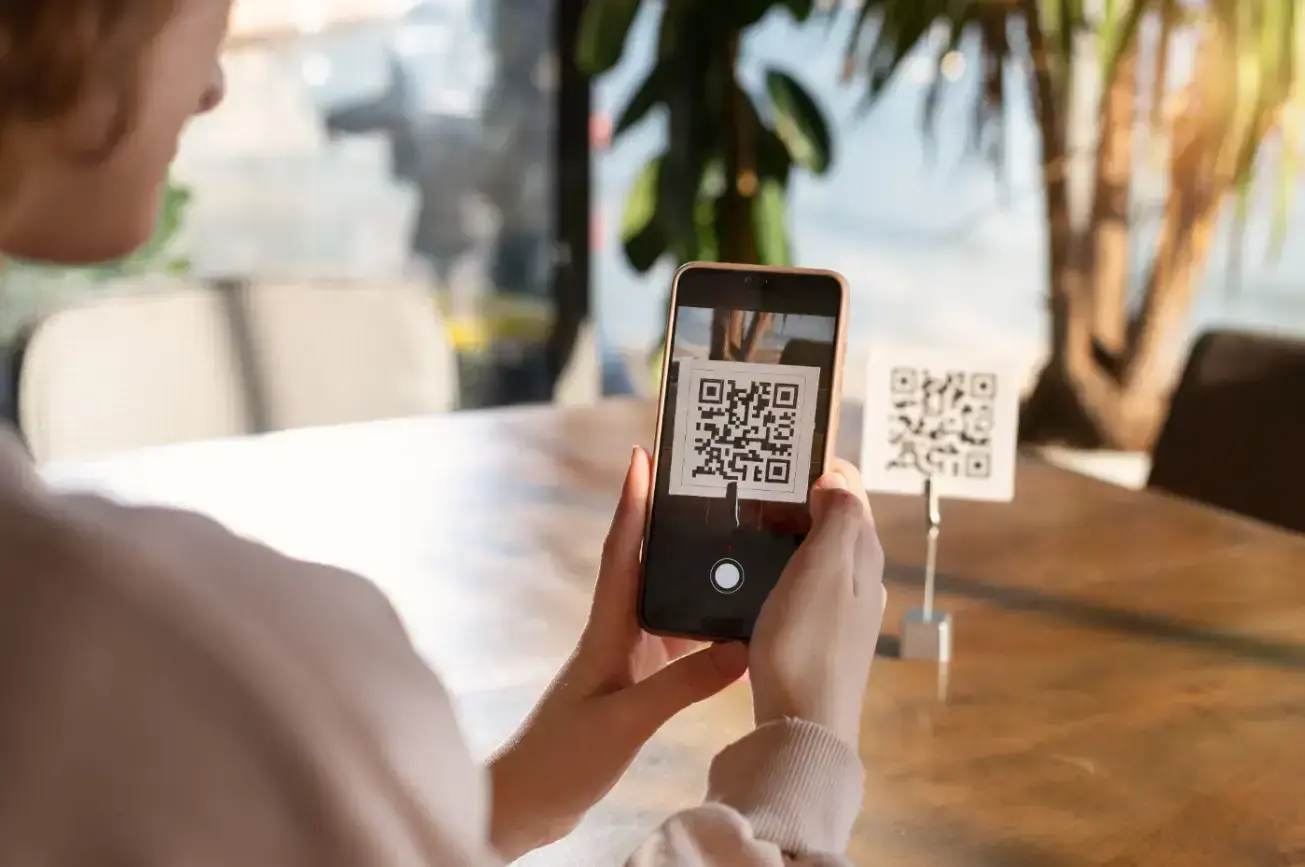Are you using a free form builder app to create interactive online forms that engage users through dynamic elements and significantly increase the likelihood of form completion?
If so, you’ll find QR codes to be of quite an assistance in your forms reaching more people. As a modern and innovative solution, QR codes offer an instant and convenient way for users to access your forms.
Article Shortcuts:

Source: Freepik
In this post, we discuss how to integrate QR codes into your marketing efforts for interactive online forms. We also provide QR-related strategies for launching the campaign and analyzing and optimizing its performance. Let’s get to business.
1. Integrating the QR Code with Marketing Materials

Source: Pexels
By strategically placing QR codes in your materials using Uniqode’s QR code generator, you not only drive traffic to interactive online forms; you also streamline the user experience and boost overall campaign effectiveness.
This makes it a powerful strategy for bridging the gap between offline and online engagement, whether done through print media or outdoor advertising. In this section, we also cover integration with digital media channels.
-
Print Media
This is still a vital channel for reaching audiences. Including QR codes in print media modernizes these traditional tools and provides an easy pathway for potential customers to engage with your digital content.
Here’s how to integrate QR codes in print media:
- Brochures — Place QR codes on brochures you distribute at events, stores, or mail to potential customers.
- Flyers — Include QR codes on flyers for promotions, events, or new product launches. Distribute these in high-traffic areas or include them in mail drops.
- Posters — Use large, eye-catching QR codes on posters placed in strategic locations such as malls, community centers, or public bulletin boards.
- Business cards — Add QR codes to business cards to link to your contact information, portfolio, or a custom welcome message.
- Product packaging — Incorporate QR codes on packaging to provide customers with additional product information, user manuals, or promotional offers.
-
Outdoor Advertising
This kind of advertising is aimed at capturing the attention of passersby in public spaces. By incorporating QR codes into these advertisements, you offer a direct link to your interactive online forms, allowing users to engage with your content on the go.
Tips for incorporating QR codes into outdoor advertising:
- Billboards — Place QR codes on billboards in high-traffic areas, ensuring the code is large enough to be scanned from a distance.
- Bus shelters — Use QR codes on advertisements at bus shelters to engage commuters with special offers or information, leading them to your forms.
- In-store signage — Place QR codes on in-store signs to provide customers with more information about products, upcoming sales, or to encourage joining a loyalty program through online forms.
-
Digital Media
Digital marketing platforms, such as emails, social media posts, and websites, are perfect for embedding QR codes. This integration allows you to leverage the convenience of digital interactions to drive traffic to your interactive online forms.
Use the following digital media channels:
- Emails — Embed QR codes in email campaigns to direct recipients to special offers, registration forms, or event information.
- Social media posts — Share QR codes in social media posts to drive traffic to online forms, landing pages, or promotional content.
- Website — Include QR codes on your website for easy access to downloadable content, contact forms, or surveys, enhancing user interaction in the process.
2. Launching the Campaign

Source: Pexels
Launching a QR code campaign to drive traffic to your online forms involves identifying the right audience, crafting compelling calls to action, and distributing materials effectively.
Due to the expertise and cost-saving involved, you may find that outsourcing sales development will make your life easier when it comes to lead generation.
Either way, here’s what to have in mind to maximize engagement in your campaign.
-
Audience Targeting
Identifying the right audience is crucial.
By understanding your potential users and segmenting them based on specific criteria, you can tailor your QR code campaign to meet their needs and interests, resulting in more meaningful interactions.
So, conduct market research to understand your target demographic. Use data from existing customers, surveys, and market analysis to pinpoint the ideal audience for your QR code campaign.
Once you have enough data to form customer profiles, use criteria such as age, location, interests, and purchasing behavior for effective customer segmentation. Tailor your QR code content and placement to appeal to each segment, directing them to relevant online forms.
-
Call to Action

Source: Pexels
An effectively crafted CTA is essential to motivate users to scan your QR code. Your CTA should communicate the value of engaging with your interactive online form, whether it’s to enter a contest, gain more information, or subscribe to updates.
The call to action needs to be short, direct, and, of course, action-oriented. Examples:
“Scan to Win”: Entice users with the chance to win a prize or enter a contest via an online form.
“Scan for More Info”: Direct users to detailed information about a product or service through a form.
“Scan to Subscribe”: Encourage users to subscribe to newsletters or join a loyalty program via an online form.
Another pro tip: Position the CTA near the QR code and make it visually appealing. Use contrasting colors, bold fonts, and engaging graphics to attract attention and drive scans to your forms.
-
Distribution
Strategically distributing your marketing materials ensures that your QR codes reach your target audience where they are most likely to engage. Here is how to handle distribution:
- Strategic locations — Place your marketing materials in locations frequented by your target audience. Consider high-traffic areas, events, and venues where your audience is likely to spend time, ensuring easy access to your QR codes and forms.
- Partnerships and collaborations — Partner with other businesses, influencers, or organizations that share your target audience to expand your reach.
- Timing — Launch your campaign during peak times when your target audience is most likely to engage. Consider seasonal trends, holidays, and relevant events to maximize exposure.
3. Tracking and Analytics

Source: Unsplash
Effectively tracking and analyzing the performance of your QR code campaign is essential to understanding its impact and making necessary adjustments for optimization.
In this section, we explore the methods to monitor and continuously refine your campaign for the best results.
-
Monitor Scans
Understanding how and where your QR codes are being used is the first step in evaluating their effectiveness. Using Uniqode’s QR code analytics tool, you gain detailed insights into scan activity.
This includes data on:
- Number of scans — Track the total number of times each QR code is scanned to measure interest.
- Geolocation — Identify where the scans are coming from, which helps in understanding regional engagement and planning location-specific strategies.
- Time and date — Analyze when your QR codes are being scanned the most, helping you identify peak engagement times and optimize campaign timing.
- Device information — Determine the types of devices (smartphones or tablets) used to scan the QR codes, which will inform your mobile optimization strategies.
-
Form Analytics
Analyzing how users interact with your online forms helps you identify strengths and areas for improvement in your forms.
Look at key engagement metrics to measure how users interact with your online forms. These metrics include:
- Form views — The number of times your form is viewed, indicating reach and interest.
- Form completions — The number of times users successfully complete and submit the form, reflecting conversion success.
- Completion rate — The percentage of users who complete the form out of those who view it, indicating the effectiveness of the form in capturing user information.
- Drop-off rate — The percentage of users who start but do not complete the form, highlighting potential areas of improvement.
You should also track how users navigate through your form:
- Field interaction — Identify which fields are most interacted with and which are often skipped, providing insights into user preferences and potential obstacles.
- Time spent — Measure the average time spent on each section or field. This helps to identify potential points of confusion or difficulty and refine the form for better user experience.
-
Adjusting Your Campaign

Source: Pexels
Using the insights gathered from your QR code and form analytics allows you to make informed adjustments to your campaign. This ensures your strategy remains effective and responsive to user behavior.
Informed adjustments to your campaign can include:
- Refining content — Consider simplifying or rephrasing the questions if certain sections of the form have high drop-off rates.
- Improving CTAs — Analyze which CTAs are most effective in driving scans and form completions. Adjust your messaging to emphasize these successful elements.
- Optimizing placement — Focus your distribution efforts according to scans that are higher in certain locations or at specific times.
- A/B Testing — Conduct A/B testing with different versions of your QR codes, forms, and CTAs to determine which combinations perform best.
The Power of QR Codes for Interactive Engagement
In conclusion, integrating QR codes with interactive online forms is about modernizing your marketing strategy to create more dynamic and convenient experiences.
QR codes are great this way - in fact, here at POWR we’ve been using them for all our products. QR codes enhance the customers’ journey with your brand and, at the same time, significantly increase the chances of your interactive online form being opened and completed.
In short, what’s not to like about this strategy to drive traffic to your forms?
Author Bio
Nina Petrov is a content marketing specialist, passionate about graphic design, content marketing, and the new generation of green and social businesses. She starts the day scrolling her digest on new digital trends while sipping a cup of coffee with milk and sugar.


